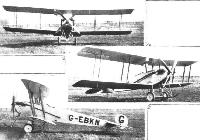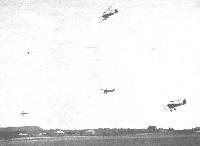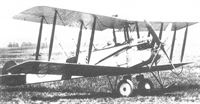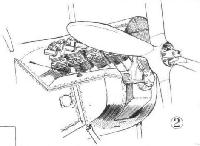
Варианты
Flight, July 1920
The Olympia Aero Show 1920
The machines
A.V. Roe and Co., Ltd. (STAND 63) Newton Heath, Manchester, and Hamble, Southampton.
The Avro "Tourist" three-seater, Type 548, is a development of the Standard Training Biplane, Type 504K, and retains the excellent aerodynamic qualities of that well-known machine. The modifications consist of eliminating the dual control and providing accommodation for seating two passengers in tandem behind the pilot who controls the machine from the original front cockpit. The nose of the fuselage is modified to provide a suitable mounting for the 80 h.p. air-cooled Renault, an engine well-known for its reliability and economy in fuel consumption. The petrol tank is fitted in the centre section, giving a gravity feed to the carburettor, thereby eliminating the usual complication of a "pressure feed" system. The machine is admirably adapted for economical touring, having a range of 200 miles, whilst for joy-riding, it possesses the same qualities of low landing speed and controllability which are the distinguishing features of the Standard Training Machine. Furthermore, the fact that standard motor-car petrol and lubricating oil can be used, precludes any possibility of delay due to lack of special fuels and oils.
The Avros
The Avro 548 is practically a standard Avro with an extra seat added and fitted with an 80 h.p. Renault engine in place of the usual rotary. The manner in which Avros have built this engine into the machine is highly commendable, the appearance being excellent, as will be seen from the accompanying sketch. The petrol tank, which has the section of a thick aerofoil, is mounted in the top centre section, giving gravity feed to the carburettor with consequent simplicity.
- Flight, July 1920
The Olympia Aero Show 1920
Фотографии
-
Flight 1920-07 / Flight
Регистрационный номер: G-EAFH [7] Avro, type 548, three-seater Tourist biplane. A modification of the standard 504K, with 80 h.p. Renault engine a combination which has several points to commend it from an aerial touring point of view
-
Aeroplane Monthly 1976-11 / A.Ord-Hume - Henderson-Glenny H.S.F.II Gadfly /British pre-war ultralights/
Регистрационный номер: G-EBAJ A unique picture of Avro 548 G-EBAJ fitted with Pearson’s rotary wing-tip ailerons, their first installation on an aircraft. The 548 was powered by an 80 h.p. Renault and was a three-seater.
-
Flight 1920-07 / Flight
The Avro Tourist at Olympia: The mounting of the Renault engine is very neatly carried out
-
Aeroplane Monthly 1987-07 / Personal album
The Henderson School of Flying’s Avro 548 flying pleasure trips from the beach at Skegness in 1927. This Renault-powered 504 variant was normally based at Brooklands.
-
Flight 1921-09 / Flight
Регистрационный номер: G-EAFH [7] THE FIRST CROYDON AVIATION MEETING: The line-up for the third event, the First Croydon Handicap.
-
Flight 1923-07 / Flight
THE DE HAVILLAND FLYING SCHOOL: Some of the school machines in use lined up. In the foreground, the Avro-Renaults used for preliminary work, and farther back some of the D.H.9's, with "Puma" engines, on which more advanced instruction is given.
Другие самолёты на фотографии: De Havilland D.H.9 - Великобритания - 1917
-
Aeroplane Monthly 1984-12 / J.Viner, R.Riding - Doctor in the sky
Регистрационный номер: G-EAFH [7] Further view of the doctor flying his Avro 548 at Bekesbourne. Avro 548 G-EAFH was destroyed at Southport on May 31, 1935 following a low-level aerobatic display over the beach.
-
Aeroplane Monthly 1984-12 / J.Viner, R.Riding - Doctor in the sky
Регистрационный номер: G-EAFH [7] Dr Whitehead Reid flying his Avro 548 for the benefit of Flight’s photographer in June 1927. The large hangar he occupied at Bekesbourne, Canterbury, is in the background.
-
Aeroplane Monthly 1984-12 / J.Viner, R.Riding - Doctor in the sky
Регистрационный номер: G-EAFH [7] BRITAIN'S FIRST POST-WAR PRIVATE OWNER: Dr. Whitehead Reid, of Canterbury, registered both his machines as long ago as 1922 - the Avro-Renault on March 31, and the S.E. 5 on October 20. As he was, and still is, totally unconnected with the aircraft industry, he can justly claim to be our first private owner. The photograph shows Dr. Whitehead Reid flying his Avro. Note the commodious hangar in which he keeps his machines.
-
Flight 1921-09 / Flight
Регистрационный номер: G-EAFH [7] THE FIRST CROYDON AVIATION MEETING: F.G.M.Sparks, on the Renault Avro, winning the first race.
-
Flight 1921-09 / Flight
Регистрационный номер: G-EAFH [7] THE FIRST CROYDON AVIATION MEETING: Sparks takes off on a climbing turn in the third race.
-
Flight 1927-05 / Flight
Регистрационный номер: G-EAJB THE FIRST AERO FILLING STATION: The Anglo-American Oil Co., Ltd., have recently established a petrol filling station - the first in this country - at Brooklands, where aircraft, like the Henderson's Flying School Avro shown in our illustration, can fill up with "Pratts'" Spirit speedily and easily.
-
Flight 1923-07 / Flight
The De Havilland Flying School: Telephones are used so as to facilitate instruction. This contrasts with the old-fashioned method by which the instructor used to knock the pupil on the head to indicate that he had made a mistake.
-
Flight 1925-07 / Flight
The Airdisco-Avro is a standard Avro biplane, but fitted with 120 h.p. Airdisco engine. The machine has been entered by Colonel Barrett Lennard, and will be piloted by Mr. H. H. Perry
-
Aeroplane Monthly 1982-07 / P.Capon - Capon's Corner
Регистрационный номер: G-EBHL, H2067 In 1920 A.V.Roe began converting Avro 504s into three seaters for the private pilot market powered by the in-line, air-cooled 80 h.p. Renault. One of the 30 or so British Avro 548s, as the type became known, was G-EBHL, ex H2067, photographed at Stag Lane some time during 1925, the same year that it was written off in an accident. 'HL was owned by the de Havilland Aircraft Company Ltd and is seen parked in front of the World War One Stag Lane sheds.
-
Aeroplane Monthly 1979-10 / D.Brown - Wings over Sussex (2)
Регистрационный номер: G-EBKN [3] This Avro 548A was owned by A. G. Head at Shoreham, who also took the heading photograph to this article. Parts of it were used to rebuild G-EBJE for the RAF Museum.
-
Flight 1925-02 / Flight
Регистрационный номер: G-EBKN [3] AN AIRDISCO "AVRO": This machine, an Avro 504, is fitted with the new Airdisco engine of 120 h.p. The "Cirrus" engine is developed from this engine, being in effect one-half of it, cylinders and pistons being interchangeable. The Avro-Airdisco should be a very useful training machine of the medium-power type.
-
Flight 1925-07 / Flight
Регистрационный номер: G-EBKN [3] THE KING'S CUP: Some of the first day's starters. 1, Perry, off on the "Airdisco" Avro, 120 h.p. Airdisco engine.
-
Flight 1925-07 / Flight
THE KING'S CUP: Donoghue's D.H.51A, "Come on, Steve," piloted by C. D. Barnard, and the "Airdisco" Avro (W. H. Perry), waiting for their signal to start.
Другие самолёты на фотографии: De Havilland D.H.51 - Великобритания - 1924
-
Flight 1925-08 / Flight
HEADING FOR POSTLING: In the lead is the Airdisco "Avro," followed by the Pander monoplane, above which is seen the De Havilland "Moth" flown by Broad, with Cobham on the second "Moth" in hot pursuit.
Другие самолёты на фотографии: De Havilland Moth / D.H.60 - Великобритания - 1925Holland (VIH) H.2 - Нидерланды - 1924
-
Air Enthusiast 1998-05 / R.Niccoli - Portuguese Numerology
One of two Avro 548As operated alongside the large batch of 504Ks.
-
Flight 1920-07 / Flight
Sketch showing the neat mounting of the Renault engine in the Avro "Tourist"
-
Flight 1925-08 / Flight
A FEW DETAILS AT LYMPNE: 2. The Airdisco engine and its mounting in the Avro 504.
- Фотографии























